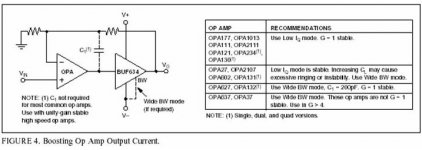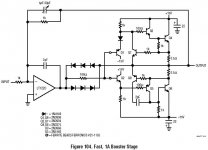preamp (stereo) pcb layout
Hi Alcaid,
Could you pls post the layout in actual size so that i could take a printout for the PCB. I am interested in fabricating a PCB with OPA2134 and BUF634.
thanks,
skmenon
Hi Alcaid,
Could you pls post the layout in actual size so that i could take a printout for the PCB. I am interested in fabricating a PCB with OPA2134 and BUF634.
thanks,
skmenon
Alcaid said:There is a series resistor on the input inside the BUF634T. Don't know if this does the job though.
Alcaid & Christer,
I think the external input resister is to isolate input capacitive coupling to other parts of the circuit. That would happen externally for instance between pins or between the input pin and a ground plane or tracks. The internal 200 ohms series resistor wouldn't help against that. That one I think is there to limit input current in case of overdrive when the diode string(s) start to conduct.
Does that make sense to you?
Jan Didden
PS Isn't it amazing how much you can take out of such a seemingly simple sicrcuit?
janneman said:
Does that make sense to you?
Hm, maybe? Have only had one cup of coffee yet. 🙂
PS Isn't it amazing how much you can take out of such a seemingly simple sicrcuit?
If you think something is simple, you just haven't been
thinking deep enough about it. 🙂 It holds for everything,
not just electronics.
I thought some more about the output resistor and I think
the important point is that the diamond buffer itself has an
output impedance of, I would guess, at least 5 to 10 Ohms
due to the emitter resistors. If you have a heavily capacitive
load this will cause phase that might affect the feedback
more than you want. The series resistor will decrease this
effect, but only if you take the feedback before the resistor.
Unfortunately you don't get the benefit of the low output
impedance feedback can give you, but in return you get
better stability. Of course, the higher the resistance, the
better isolation against capacitive loads you get, so it is
a compromise in the end. If I remember right, Jung's discrete
diamond buffer has a Zout of 5 Ohms and he recommends
a 5 Ohm output resistor (or was it 10 Ohms?).
Jan, have you tested this yourself, about the resistor? Don't forget that the resistor is built-in in the BUF634.janneman said:Neither Alcaid's nor P-A's schematic show the series input R. They must love to live dangerously...
So the circuit looks like PMA's? At the bottom the schematic says "P-A Sjostrom". Funny...
About your last remark: An opamp + buffer isn't something unusual and have you checked Tangent's headphone amp? As you can see I have followed the datasheet pretty closely.
Per-Anders, if you read the datasheet, or the the particular
quote that Jan posted you will see that BB actually recommends
an external input series resistor, or rather say that it can improve
performance in many cases.
Edit: Correction, Jan didn't quote the pasage from the
datasheet, but he mentioned the use of such a resistor.
It's in the datasheet anyway, as is the output resistor.
quote that Jan posted you will see that BB actually recommends
an external input series resistor, or rather say that it can improve
performance in many cases.
Edit: Correction, Jan didn't quote the pasage from the
datasheet, but he mentioned the use of such a resistor.
It's in the datasheet anyway, as is the output resistor.
Alcaid said:By the way, Christer:
I went to Biltema today and bought the glossy photo paper. Thanks alot for the great guide.
Don't start with the sharp version at once. Take for instance
just a part of the layout and try on some small pieces of
PCB you have left-over. It takes a little bit of practice to
get the technique right and get a feel for it. Or you can
print just about anything, like a piece of text or whatever
just for testing the transfer method.
PMA has measured disortion plots on his website for this buffer when used with different op amps and different terminations. He claims ultra low distortion when used with OPA 627 and a 50 ohm line termination resistor - something like 0.001 %, i.e. harmonics below a -90 dB noise floor.
Yes, but it is the feedback on work and hence the result does not say much about the distortion of the buffer itself. Thanks anyway.
Re: preamp (stereo) pcb layout
Here are pdf files, but you can't use a opa2134, because it's a dual opamp, and this design is for single ones.
bottom layer:
skmenon said:Hi Alcaid,
Could you pls post the layout in actual size so that i could take a printout for the PCB. I am interested in fabricating a PCB with OPA2134 and BUF634.
thanks,
skmenon
Here are pdf files, but you can't use a opa2134, because it's a dual opamp, and this design is for single ones.
bottom layer:
Attachments
High Speed Amplifier Design Application Note
Hi, An explanation for all this (driving a buffer with a high speed opamp) is beautifully explained in this application note by Jim Williams of Linear Technology:
http://www.linear.com/pub/document.html?pub_type=app&document=50
Even features a discrete and better sounding buffer than the BUF634........
Hi, An explanation for all this (driving a buffer with a high speed opamp) is beautifully explained in this application note by Jim Williams of Linear Technology:
http://www.linear.com/pub/document.html?pub_type=app&document=50
Even features a discrete and better sounding buffer than the BUF634........
janneman said:There is some more stability info on the '634 data sheet, relative to the selected opamp: (hope you can read it)
Jan Didden
Have read it, and I'm using wide BW and the 200pF is on my layout.
Re: High Speed Amplifier Design Application Note
This is interesting, but I have the buffers, and going discrete would cost me more. Maybe a version 2 though 🙂
Elso Kwak said:Hi, An explanation for all this (driving a buffer with a high speed opamp) is beautifully explained in this application note by Jim Williams of Linear Technology:
http://www.linear.com/pub/document.html?pub_type=app&document=50
Even features a discrete and better sounding buffer than the BUF634........
This is interesting, but I have the buffers, and going discrete would cost me more. Maybe a version 2 though 🙂
Re: High Speed Amplifier Design Application Note
Hi Elso,
Very interesting! Thanks. Williams is one of my hero's, I have lots of app notes from him (and his two books of course).
Required reading if you're serious about this!
Jan Didden
Elso Kwak said:Hi, An explanation for all this (driving a buffer with a high speed opamp) is beautifully explained in this application note by Jim Williams of Linear Technology:
http://www.linear.com/pub/document.html?pub_type=app&document=50
Even features a discrete and better sounding buffer than the BUF634........
Hi Elso,
Very interesting! Thanks. Williams is one of my hero's, I have lots of app notes from him (and his two books of course).
Required reading if you're serious about this!
Jan Didden
Alcaid said:forgot picture:
Hmmm. I wonder how this could be morphed into a power amp...?
Jan Didden
janneman said:
Hmmm. I wonder how this could be morphed into a power amp...?
Jan Didden
Now that's an interesting idea. An OPA627 poweramp, or even better, an OPA637 poweramp. 🙂
- Status
- Not open for further replies.
- Home
- Amplifiers
- Solid State
- OPA627 + BUF634 Preamp PCB Design

